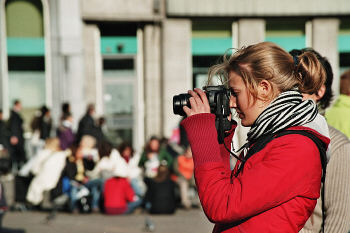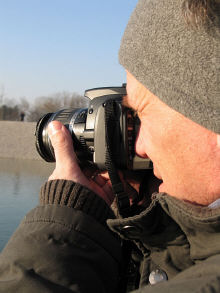Pros & Cons of Bringing a Camera on Your Trip
by BootsnAll
 Most people we know take some kind of camera with them when they travel. What you bring can range anywhere between disposable cameras to the camera on your cell phone to an entire specialty backpack full of expensive camera bodies and lenses. No matter where you fall the photographer spectrum, you’ll need to weigh your options before you decide what camera gear you’ll bring – or whether you want to take any kind of camera gear at all.
Most people we know take some kind of camera with them when they travel. What you bring can range anywhere between disposable cameras to the camera on your cell phone to an entire specialty backpack full of expensive camera bodies and lenses. No matter where you fall the photographer spectrum, you’ll need to weigh your options before you decide what camera gear you’ll bring – or whether you want to take any kind of camera gear at all.
Why You Should Bring a Camera
- Record your memories: You may not want to take the time out to jot down your thoughts in a journal or even on a blog every day, but having a camera in your pocket means you can quickly snap a photo or two (or twelve) and then later, by looking at those pictures, re-live the experience. Trip photos are excellent memory triggers – they show where you went, what you saw and who you did it with. They help keep events in chronologial order and answer important questions like “Did I meet that sensational Swede in France or Spain?” and “What Prague bars did we do shots of absinthe in?” They are also excellent complements to your journal, scrapbook or other trip memorobilia.
- Highlight your trip: It’s much easier to tell a story with pictures. When you get back home, pictures are the easiest way to prove to the folks back home that you really did dance on the table in the Oktoberfest tent. And who knows? You might even inspire them to travel, too. If you’ve ever had dreams of being a travel photographer, you can even submit your pictures to travel competitions!
- Blackmail: An extension of the “remember your memories” line of thought, but better – you get to remind other people of theirs, whether they want you to or not.
Why You Should Not Bring a Camera
- Expensive, recurring costs: Cameras are pricey – and it isn’t just the initial investment. The costs of flash cards, camera batteries, film and print development can add up. Flash cards are those removable cards that store the pictures on digital cameras. They can be re-used, but if you don’t have access to a computer that allows you to download your pictures, you’ll be forced to erase some, buy another card, or pay for someone to burn them to a CD along the way in order to make room for more photos. Batteries always go a lot quicker than you realize (and not all cameras use rechargable batteries), and film and development costs can average up to $10 USD for a standard 24-shot roll!
- Warning! Fragile!: Cameras break when dropped. LCD screens go out. Lenses get scratched. Water destroys components. Film gets damaged by heat, X-rays and the drinks your buddy spills on the table. Flash cards are easily crushed. If you can’t be careful with your things, there’s a chance your camera won’t make it through your rough and tumble trip.
- Easy to lose: People usually take cameras everywhere with them – which increases the likelihood that they are going to be forgotten somewhere along the road, or stolen from a day bag.
- Tigger-happy syndrome: Sometimes, people become obsessed with taking pictures of EVERYTHING, to the annoyance of their subjects, their travel companions and even the photo-phile himself. The pressure to bring the camera and be snap-happy can actually be detrimental when you’re too busy trying to record the experience rather than live it.

Should you bring a camera with you?
BootsnAll Sez: Yes, a thousand times yes! For us, this is no contest. Having a camera along is always a good thing. The more baffling question might be what kind of camera to take. For information to help you make that decision, read on…
What are my camera options?
Your choices these days have been winnowed down to one major decision you’ll need to make: To go digital, or not to go digital – that is the question! The quality, price, and features can vary widely within both categories, and between them as well. There are plenty of crappy digital cameras that are far worse than many film cameras, too, so more technology doesn’t necessarily mean it’s better. Lots of travelers have made the move to digital photography, but there are still plenty of film camera lovers out there. If you’ve got a film camera you love and know how to operate really well, and you’re really not enthusiastic about making the jump to digital, don’t worry. Stores all over the world still sell rolls of film.
Here are some things you’ll need to know about both digital and film cameras in order to decide which option is best for you.
- Digital Cameras – Digital cameras first appeared in the early 1990s, although they didn’t enter the mainstream until right around the turn of the century. Digital cameras store their images digitally instead of on film. Most digital cameras allow pictures to be viewed almost instantly via a small LCD screen on the back of the camera. Pictures are then transferred to a computer, where they can be e-mailed, printed or put into a slide show. Unfortunately, due to the limitations of camera memory, digitizing mechanisms and printers, the best digital camera pictures cannot surpass the highest-quality film prints, but the vast majority of amateur photographers do not need to worry about the slight difference. The price range on digital cameras can go from as little as $75 USD for a basic, entry-level compact camera right up to several thousand dollars for a top-of-the-line digital SLR, but you should expect to pay at least $150-200 USD for a good mid-range digital camera.
- Film Cameras – Film cameras, which were essentially the only option for decades (and are still preferred by many professionals), store images on photographic film. There are a number of different features that distinguish the cheap cameras from the expensive cameras; the main ones being the power of the zoom and the resolution of the shots. The nicer cameras tend to have removable lenses. The more lenses, the more expensive the hobby. However, this doesn’t mean that you need to go with a point and shoot camera either. Most travelers are well-suited with a middle-of-the-line automatic flash camera that offers some zoom capability with decent resolution. Extra features like night flash and red-eye reduction are increasingly included in these cameras as well. While prices vary on film cameras, they’re getting harder and harder to come by in regular department stores. You may have better luck finding a wider selection on a website like eBay or at a professional camera shop. You could pay as little as $25 USD for a film camera, or as much as several thousand dollars – but a good, mid-range camera will run you around $250-300 USD.

Pros & Cons to Digital & Film Cameras
Pros to Film Cameras
- Many people are familiar and comfortable with non-digital cameras
- Produces higher quality and higher resolution prints
- Some use rechargable batteries
Cons to Film Cameras
- Film has to be replenished (brought along or bought along the way)
- All pictures must be developed, regardless of quality
- Film is very sensitive and can be easily spoiled
- Film is not reusable
- Can erase poor pictures
- Some cameras allow for short movie recordings
- Can choose what pictures to develop, if any
- Reusable flash cards
- Pictures can be e-mailed to friends and family or posted on a blog without the need to visit a photo shop for developing or printing
- Some use rechargable batteries
Cons to Digital Cameras
- Need to carry extra cords to be able to transfer pictures
- Can be difficult to download pictures on public computers at internet cafes, or put them on a CD
- Flash cards can be expensive
- Camera options can be numerous and complicated
- Drain batteries faster
Recommended Cameras
Non-Digital
- Olympus Infinity Zoom 80 QD 35mm Camera
- Olympus Stylus Zoom 115 QD Date 35mm Camera
- Canon Sure Shot Z155 Zoom 35mm Camera
- Canon EOS Rebel K2 35mm SLR Camera with EF 28 to 90mm II USM Lens
Digital
- Canon PowerShot SD1100IS 8MP Digital Camera with 3x Optical Image Stabilized Zoom
- Canon PowerShot SD790IS 10MP Digital Camera with 3x Optical Image Stabilized Zoom
- Panasonic Lumix DMC-TZ5K 9MP Digital Camera with 10x Wide Angle MEGA Optical Image Stabilized Zoom
- Canon Digital Rebel XSi 12MP Digital SLR Camera with EF-S 18-55mm f/3.5-5.6 IS Lens

